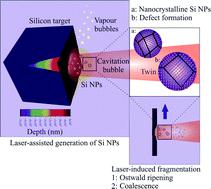当前位置:
X-MOL 学术
›
Nanoscale Adv.
›
论文详情
Our official English website, www.x-mol.net, welcomes your feedback! (Note: you will need to create a separate account there.)
The influence of the fluid nature on femtosecond laser ablation properties of a SiO2/Si target and synthesis of ultrafine-grained Si nanoparticles
Nanoscale Advances ( IF 4.7 ) Pub Date : 2020-06-23 , DOI: 10.1039/d0na00317d Niusha Lasemi 1 , Christian Rentenberger 2 , Gerhard Liedl 3 , Dominik Eder 1
Nanoscale Advances ( IF 4.7 ) Pub Date : 2020-06-23 , DOI: 10.1039/d0na00317d Niusha Lasemi 1 , Christian Rentenberger 2 , Gerhard Liedl 3 , Dominik Eder 1
Affiliation

|
Nanocrystalline silicon nanoparticles with a median crystallite size of 3–4 nm and several crystalline phases and defects (e.g. twin boundary) were produced by femtosecond laser processing of a SiO2/Si target in various organic fluids. Furthermore, a nanoscaled amorphous oxide layer and a few atomic layers of a graphite shell were detected in ethanol and 2-butanol correspondingly. The ultrafast laser pulses may manipulate nanostructures at the atomic level and generate a high density of defects; this may be correlated with significant thermal stresses on nanoparticles and rapid condensation of primary nanoparticles with high cooling rates. Size distribution width and a polydispersity index slightly increased with increasing laser fluence in ethanol. In 2-butanol, the maximum ablation volume was observed. The specific ablation rates in 2-butanol and ethanol were approximately five times higher than n-hexane. The lowest ablation efficiency in n-hexane can be associated with femtosecond laser-induced photolysis and pyrolysis of solvent molecules, as total energy deposition on the material may be reduced due to the formation of carbonaceous products. The roughened zones (average roughness of ∼400 nm) in circumferences of the ablated craters in 2-butanol may be related to a correlation between the erosive power of the vapour bubble collapse and higher pressure at the bubble wall in relatively high dynamic viscosity fluids. Furthermore, sputtering of a pristine surface by releasing nanoparticles from the collective collapse of up-flow vapour bubbles can also contribute to the generation of roughened regions.
中文翻译:

流体性质对 SiO2/Si 靶材飞秒激光烧蚀性能的影响及超细晶 Si 纳米粒子的合成
通过 SiO 2的飞秒激光加工产生中值微晶尺寸为 3-4 nm 和几个晶相和缺陷(例如孪晶界)的纳米晶硅纳米颗粒/Si 靶材在各种有机流体中。此外,相应地在乙醇和2-丁醇中检测到纳米级无定形氧化物层和石墨壳的几个原子层。超快激光脉冲可以在原子水平上操纵纳米结构并产生高密度的缺陷;这可能与纳米粒子上的显着热应力和初级纳米粒子在高冷却速率下的快速冷凝有关。随着乙醇中激光能量密度的增加,尺寸分布宽度和多分散指数略有增加。在 2-丁醇中,观察到最大消融体积。2-丁醇和乙醇中的特定消融率大约是正己烷的五倍。n中最低的消融效率-己烷可能与飞秒激光诱导的溶剂分子的光解和热解有关,因为由于碳质产物的形成,材料上的总能量沉积可能会减少。2-丁醇烧蚀坑周围的粗糙区域(平均粗糙度约为 400 nm)可能与相对高动态粘度流体中气泡破裂的侵蚀能力和气泡壁处的较高压力之间的相关性有关。此外,通过从向上流动的蒸汽气泡的集体坍塌中释放纳米粒子来溅射原始表面也可能有助于粗糙区域的产生。
更新日期:2020-06-23
中文翻译:

流体性质对 SiO2/Si 靶材飞秒激光烧蚀性能的影响及超细晶 Si 纳米粒子的合成
通过 SiO 2的飞秒激光加工产生中值微晶尺寸为 3-4 nm 和几个晶相和缺陷(例如孪晶界)的纳米晶硅纳米颗粒/Si 靶材在各种有机流体中。此外,相应地在乙醇和2-丁醇中检测到纳米级无定形氧化物层和石墨壳的几个原子层。超快激光脉冲可以在原子水平上操纵纳米结构并产生高密度的缺陷;这可能与纳米粒子上的显着热应力和初级纳米粒子在高冷却速率下的快速冷凝有关。随着乙醇中激光能量密度的增加,尺寸分布宽度和多分散指数略有增加。在 2-丁醇中,观察到最大消融体积。2-丁醇和乙醇中的特定消融率大约是正己烷的五倍。n中最低的消融效率-己烷可能与飞秒激光诱导的溶剂分子的光解和热解有关,因为由于碳质产物的形成,材料上的总能量沉积可能会减少。2-丁醇烧蚀坑周围的粗糙区域(平均粗糙度约为 400 nm)可能与相对高动态粘度流体中气泡破裂的侵蚀能力和气泡壁处的较高压力之间的相关性有关。此外,通过从向上流动的蒸汽气泡的集体坍塌中释放纳米粒子来溅射原始表面也可能有助于粗糙区域的产生。


























 京公网安备 11010802027423号
京公网安备 11010802027423号